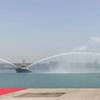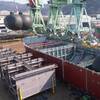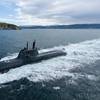The Port of Houston Authority (PHA) signed the federal permit for the Bayport Container and Cruise Terminal on Monday. The permit was then issued after Col. Leonard Waterworth signed it. The U.S. Army Corps of Engineers' permit was the next critical step in the process to build the $1.2 billion terminal. Construction is expected to begin soon. "We have always felt that this step would occur," said Jim Edmonds, PHA commission chairman. "We were pleased to receive and sign the Corps' final permit."
The Corps studied the port authority's Bayport terminal for more than five years, reviewing the site location and the environmental impacts the terminal might pose.
The port authority received concurrence from numerous state and federal agencies charged with protecting and preserving the Texas coastal environment. The port authority and the Texas Parks and Wildlife Department signed a memorandum of agreement on the port authority's plan to preserve coastal prairie habitat. Additionally, three other agencies, which previously had raised concerns about the environmental impacts of the proposed Bayport project, submitted written statements to the Corps endorsing the port authority's wetland and coastal prairie preservation plan.
The statements from the U.S. Environmental Protection Agency, U.S. Fish and Wildlife Service, and Texas Commission on Environmental Quality generally conclude that the port authority's plan adequately addresses their concerns and establishes appropriate conditions that should be included in a permit for Bayport. Statements from the office of the Governor of Texas and other elected officials also support the port authority's plan.
"The Port of Houston Authority has worked diligently with numerous groups during Bayport's planning," Edmonds said. "Developing a mitigation plan that satisfies the wide variety of stakeholders - including residents, regulatory agencies and customers -- has been a lengthy task. However, we believe that we have a better product because of this process."
Air emissions reduction, solid waste recycling and storm water quality improvement are the key objectives of the port authority's environmental management system. Another mitigation measure planned for the Bayport facility is a three-mile long buffer zone around the facility that will include a landscaped sight and sound berm that will be 20 feet tall. The buffer zone also includes part of an extensive storm water collection system that will protect Galveston Bay. Lighting systems designed to use black light poles and specially designed fixtures will limit night-time impacts at the facility
The TCEQ issued its 401 Water Quality Certification on Dec. 16, 2003, verifying the port authority's mitigation plan for wetlands at Bayport meets or exceeds state and federal laws. Additionally, the Texas Coastal Coordination Council was asked by the Bayport opposition to perform a full coastal consistency plan review for Bayport. On December 29, 2003, the 11 voting members of the CCC declined to refer the document for review by the full CCC membership, and the Bayport project was allowed to continue.
In June 2003, a group of local municipalities and organizations filed a federal lawsuit against the U.S. Army Corps of Engineers, contending that the Corps' delineation of jurisdictional wetlands is improper and that the Corps should release a supplemental environmental impact statement on the Bayport project. The lawsuit did not name the port authority as a defendant; however, four months later, the port authority's legal counsel filed to intervene in the pending federal court lawsuit.
In addition to requesting a supplemental EIS, the suit asserted other challenges to the Corps' review of the Bayport project, including the Corps' delineation of jurisdictional wetlands at the Bayport site.
"By intervening in the lawsuit, we are seeking to protect the port authority's rights and prevent further delays that could significantly harm the region's economy and job base," Edmonds said. "The lawsuit is a baseless challenge to the validity of the Corps' process. The documents filed with the court clearly explain why the plaintiffs' challenge will fail."
The Corps released its final record of decision on Dec. 19, 2003, stating that "...even if the Corps were to conclude that all of the aquatic areas on the site, including all of the wetlands on the site, were subject to CWA (Clean Water Act) jurisdiction, (PHA) has provided ample mitigation to compensate for the loss of all aquatic areas on site that will be filled or otherwise degraded by the project. Consequently, the CWA Section 404 permit that the Corps proposes to issue would still be fully justified in this case by the generous mitigation package offered by (PHA)."
"We look forward to breaking ground at Bayport to accommodate the needs of our customers, enhance the Texas cruise industry, promote economic development and foster job creation," Edmonds said.
Featured videos

Xenos Marine Takes Aim at the Gulf Salvage, Decommissioning Markets

AI to the Rescue: Zelim’s ZOE to be Installed on Cruise Ship
April 2025
 Read the Magazine
Read the Magazine

 Read the Magazine
Read the Magazine
This issue sponsored by:

Applying and Measuring Deterrence – to Maritime Security and More
Subscribe for
Maritime Reporter E-News
Maritime Reporter E-News is the maritime industry's largest circulation and most authoritative ENews Service, delivered to your Email five times per week









